A series of ignitions, from smallest to largest (detonator, lead, booster), designed to set off the munition (bomb or missile), comprised of switches and firing circuits to release safety devices.
What are Explosive Materials, aka “The Explosive Train”?
These are not allowed in offices, cubicles, conferences rooms, or break areas.
What are explosive components, sub-assemblies, or assemblies?
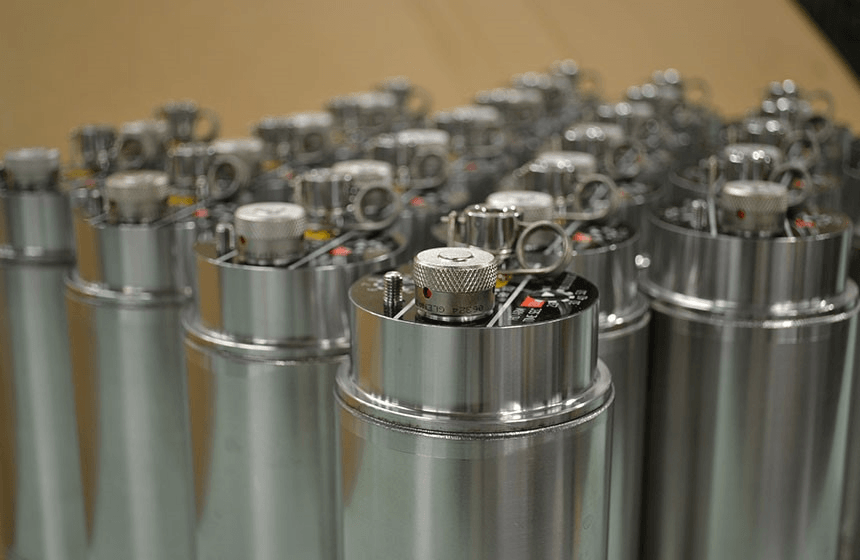
What are these?
What is the Joint Programmable Fuze (JPF). Highest volume we make, reprogrammable in flight. Comprised of a detonator, lead, and a booster.
Provides enough explosive power to set off the bomb or missile.
What is a booster pellet?
Used in Detonators, Igniters, and Primers (lead azide, lead styphnate, mercury fulminate & others). These are the most sensitive (easy to detonate) of the groups.
What are Primary Explosives?
This special color represents an inert fuze.
What is blue?
This is an example of an explosive train (With what type of barrier?)
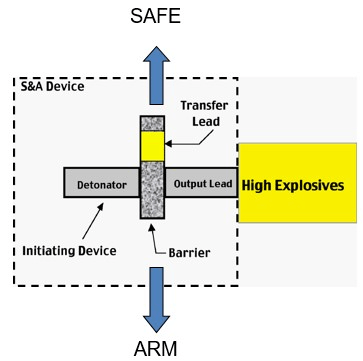
In ------- mode, the detonator is not in alignment with the transfer lead, so that if the detonator were to go off, nothing else would happen (The chain is incomplete). In arm mode the chain would continue and set the device off.
What is safety?
Fill in the blank:
Expose the ______ number of people to the ______ amount of explosive for the _______ amount of time.
What is minimum?
“Expose the minimum number of people to the minimum amount of explosives for the minimum amount of time.” - Cardinal Rule of Explosive Safety.
These are only produced in Orlando, FL and Kaman is the sole source provider of these fuzes.
What is Joint Air to Surface Standoff Missile (Or JASSM)?
This individual and the individual performing a given task are responsible for assuring compliance with the ESM, ESOP, and other work documents. Before assigning work this individual shall verify the employee has been certified to perform the task. Under no circumstances shall an employee perform a task they have not been certified for unless they are under direct supervision of a certified employee.
Who is the Team Lead/Supervisor/group lead/QE?*
Used in Explosive Leads, Boosters, and Main Charges (RDX, PETN, PBXN-7/PBXN-9). Less sensitive, much higher yield.
What are Secondary Explosives?
This special color represents a live fuze.
What is yellow?
These contain polymer-bonded explosives such as PBXN-7 or PBXN-9. About 95% is highly explosive material (RDX or HMX), the rest is a binder such as plastic. They require a high-velocity impingement or a shock wave (from a secondary explosive like an explosive lead) to detonate; is not sensitive to ESD, friction, low-velocity impact, pressure or heat. Detonation would cause extreme, permanent tissue and bone injuries that would likely be fatal.
What are booster pellets?
This document, along with the training, diligence and alertness of the people of KPP/I, is essential to achieving the safety goals of the company. All explosive handlers should become familiar with this document, which is located on the Kaman Intranet (DocuShare). If you do not have access to the Kaman Intranet, your supervisor can help you with access to this document.
What is the Explosive Safety Manual?
This helps keep the fuze in SAFE mode until it is exposed to a unique environment, such as the launching of the missile or the dropping of a bomb. For example, when a bomb equipped with a JPF fuze is dropped, this item opens up. The air stream initiates rotation of the turbine. This rotation is what powers the fuze – like the alternator in your car, the rotating parts generating electrical energy to provide power (Rotor, Survivable, gag rod).
What is a FZU?
Fill in the blank.
ALL applicable work document/procedures (OPs, TDs, ECNs), including non-routine tasks, require explosive safety approval _____ to release to manufacturing.
What is PRIOR?
Used in gas generators to propel an object by burning at a controlled rate (potassium perchlorate). Used like a model rocket motor, bad lunch at Taco Bell, the one uncle we all have….
What are Propellants?
(Also ATF Regulated).
This special color is used in JASSM, representing a live fuze for testing only.
What is brown?
Note: PBXN-7/PBXN-9 Booster pellets
Pink or metallic = inert (“dummy” booster)
Yellow or off-white = live
They are the most sensitive part of the explosive train. Detonators are a part of these, used to initiate the detonation process. There are 3 different types:
Electricity (electric detonators) (We use these the most at KPP/I).
Percussion (percussion primers)
Friction (stab detonators)
What are Primary Explosives?
Compliance (Identifies the federal, state and local regulations for which we must be compliant.), Operations (Provides guidance to minimize the exposure of personnel to hazardous explosives operations.), Handling (Describes methods for the safe handling of explosives during inspection, assembly and testing.), Transportation (the requirements for the safe transportation of explosives), and Disposal (Explains how to safely dispose of explosives) are found in this document.
What is the Explosives Safety Manual?
The FZU (JPF), G-weights (M100 Hawk Fuze), and differential air pressure (Tomahawk Fuze) are different types of these.
What are environmental sensors?
Fill in the blank.
Work documents, including ESOPs, OPs and drawings shall be reviewed _____ to commencement of work.
What is PRIOR?
Fill in the blank.
EEDs are very sensitive to electric energy such as that which can be generated by this.
A good example of ------- is the spark that is generated when you walk across a room and touch a metal object.
This spark is powerful enough to initiate an EED. Human Body potential energy storage: 500,000 Millijoules. A MK-71 will detonate at 108,000 Millijoules.
What is electrostatic discharge (ESD)?
This acronym is used when an emergency takes place. (What does each letter stand for?)
What is SWIM?
S-Stop-what you are doing
W-Warn-people in the immediate area
I-Inform-supervisor or emergency line
M-Manage-Help manage the situation
During a time when an accident has occurred level headed, quick action is required.
Accidents involving personnel are most critical. It is essential that procedure is followed.
These highly sensitive primary explosives are initiated by an electric current that passes through a thin metal wire called a bridgewire.
What are Electro-Explosive Devices (EEDs)?
This regulation covers facilities construction for explosive storage, recordkeeping, reporting requirements, requires License to do business, lists Responsible Persons – makes decisions, policies & procedures as well as employee possessors – anyone that physically handles explosives; movement, assembly, test, inspection.
What is the ATF Publication 5400.7 / Bureau of Alcohol, Tobacco, Firearms & Explosives (BATF&E)
This is a metal shell packed full of explosive material, used to amplify and transfer the explosive energy to the next explosive element in the train. There is a green end /output and a blue end/input. One example of this is the MK-8 or the M12.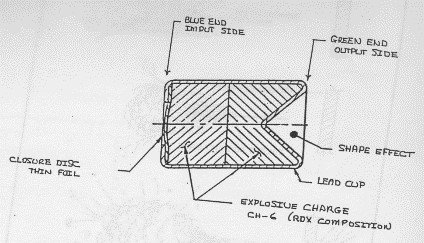
What is an explosive lead?
This shall be made readily available during the performance of the operations. All work associated with detonators or other electro-sensitive devices must be done in designated areas using proper protective shields/barricades, PPE, etc., as identified in this document(s) or work documents. Operators shall only work on the operations (tasks) assigned to them by their supervisor.
What is an ESOP/OP/TD?
These are the several different ways of grounding and protecting yourself while handling EEDs.
What are:
-Foot stats or Conductive Shoes when required, Wrist Straps always.
-Handle EED at the end with the wires.
-Always keep the end opposite the wires pointed away from you.
-Always handle Explosives as far away from your body as possible (protective Lexan shielding)?
The number to call in the event of an emergency.
What is: 8-9011 (ORL), 8-4333 (MDL): Security will notify emergency responders as needed:
For explosive incidents:
First Aid Responders;
Area Supervisor;
Explosive Safety Committee;
EHS
This heats the ignition charge and arcs out, resulting in setting off the detonator. In the drawing, the wires of this need to be kept together (soldered or twisted) which eliminates the chance of receiving the current which would set it off.
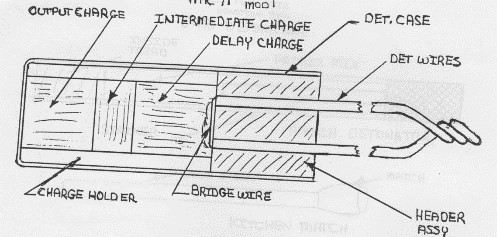
What is a bridgewire?
Actual possession: Anyone who comes in direct contact with an explosive (doesn’t matter if it’s packaged or opened) – production, quality, engineering, shipping/receiving, etc.
Constructive possession: Anyone who specifies, purchases, tests, expends, controls the handling of, or otherwise indirectly comes in contact with an explosive – supply chain management, supplier quality, engineering, program management, contracts, etc., plus anyone who supervises an Employee Possessor.
These two categories are this.
What are Employee Possessors?
Includes Piston and Retractable, used to unlock or release mechanisms such as a rotor.
What is an actuator?
Prior to starting work, verify this condition of the unit. For example:
M100: Red = Armed, White = Safe (M100 Hawk Fuze)
Fuzes with gag rod: No safing pin, gag rod extended = Armed
Safing pin is tight = Unsafe (not yet armed, may be partially expended) Safing pin is loose = Safe
NOTE: Units may not be locked in safe position. Use caution!!!
What is verifying the safe/arm mode? Fun fact: There is ONE FUZE Kaman makes that will self arm if left in the incorrect orientation. Learn what safe and arm look like.
These explosives are used to amplify and transfer the detonation to another element of the explosive train. These explosives are usually much more powerful than primary explosives, but they are not as sensitive to initiation. Never transport or store these type of explosives with primary explosives (e.g. don’t store Mk-8 leads and Mk-71 detonators in the same place). Keep them separate until ready for use. Most of these explosives used at KPP/I come in the form of explosive leads.
What are secondary explosives?
Note: Think of primaries like that one guy we all know who gets mad at the drop of a hat and is always ready to go off but wont really hurt anyone. Secondary's are like the guy who takes a lot to anger but when he goes off people need to go to the ER. Boosters take years to get angry but end up going on a killing spree.
Fill in the blank.
Detailed work instructions shall be created, and approved by the cognizant ME/QE and the ESC _____ to the commencement of any machining activity.
What is prior?
The machining Group Leader and a member of the ESC shall ensure the equipment to be used meet minimum standards required for the work to be performed.
All work shall be performed in the sensitive device machining area. Exceptions must be approved in writing by the ESC. Additional consideration shall be given in the event that work must be performed on units not in a safe condition.
Used to initiate or start the detonation of the explosive train; e.g. Mk71, MK85, Short, Long, etc.
What is a detonator?
This form will be submitted to the ATF/BATF&E prior to handling explosives to ensure you are cleared to handle explosives (for new hires). This form will also be completed every 3 years to renewal the ATF license.
What is the employee possessor questionnaire?
These are used to move shafts and open valves.
What is a gas generator?
These need to take place prior to starting work: During loading operations, electro-sensitive devices shall be kept in non-propagation type blocks. During assembly and processing operations, ESD’s shall be shunted by clips or other methods noted in applicable work documents until installed in the final device.
Prior to handling any EED or ESD individuals shall drain excess charges that may be present by touching the grounded work surface that the item is on. This puts the individual and the item at the same ground potential
What are safety checks?
Examples: the non-propagation blocks, clips, twisting or soldering to make the unit safe. If the item is on the table, you will touch the table along with wearing your wrist strap/shoes, etc. just to make sure you are on the same grounding potential and not transferring electricity to the device. Static generating plastics, envelopes or sheeting shall not be used in the ELR's. Only conductive material is allowed. All tooling and work supplies will be of conductive material, grounded or constructed as to not generate or store electro-static charges.
Piston Actuator, Bellows motor, electric delay detonator, and detonators are all considered this.
ESD Sensitive
These are the 2 items (Plus 1 additional item for certain operations.) worn for Personal Protective Equipment (PPE) at all times while in designated areas.
What are safety glasses w/ side shields, Conductive Shoes (When required), and Wrist straps? Wrist straps and shoes need to be tested and result recorded once daily.
These are initiated by the detonator. Some can explode if hammered. If you lose one, you will need to report to the ATF and the local Sheriff’s Department.
What is an explosive lead?
These items are not authorized, as well as a minimal amount of combustible material shall be permitted in any of the following areas:
Explosive Loading Room
Explosive Test Area
Explosive Storage Areas
Flammable liquids in spray or pressurized containers, including air bottles, are not permitted in the ELR.
What are fires, flame producing or spark emitting equipment.
Provides rotation/rotates a rotor.
What is a motor/bellows motor?
When the lightning is within this many miles, all work with electro-sensitive explosives, detonators, squibs, bulk powder, or units containing any of the above, shall be discontinued. Testing of units with exposed electro-sensitive devices (not in the cases) shall be discontinued. There shall be no arming tests performed where there is a possibility of the unit remaining in the armed condition due to a power failure. In the event of a power failure during testing the operator shall:
Place the main power switch in the ‘OFF’ position.
Record the phase of the test sequence where interruption occurred.
Notify the Test Engineering dept.
What is 10 miles?
These are not allowed in any production or test area, any area that stores live explosives, or any “closed” or “restricted” areas. Putting it on Airplane mode is NOT an option. Restricted areas are identified by signage and floor markings. KPP/KPPI employees may use these in break rooms, hallways, offices or outside the facility, provided that they have had the appropriate training and have signed a non-disclosure agreement. Visitors are not allowed to bring these into the facility.
What are transmitting devices?
These are cell phones, Smart Watches, Bluetooth headsets, bluetooth headphones, laptops, or any other personal electronic device that operates by transmitting a wireless signal.
Fill in the blank.
_____ to Transportation, the hazard level shall be assessed by the ELR supervisor or the ESC. Note: the assessment should include but not be limited to: Logistics of transport, pedestrian traffic, availability of personnel receiving the items etc.
What is prior?
All work shall be performed in the sensitive device machining area. Exceptions must be approved in writing by the ESC. Additional consideration shall be given in the event that work must be performed on units not in a safe condition.
General Handling (Not a question)
In most cases, handle exposed explosive components (routing leads, soldering, etc.) behind a Protective Lexan Shield or other barrier
Exceptions: There are times when components are not exposed and shielding is not required; also, work instructions may direct work outside the shield (staking, curing, etc.)
Always follow the work instructions exactly
Movement from Storage to work station and vice versa are also exceptions
Must be in proper containers (e.g. static bags, covered totes)
Note on Machining:
The following general practices shall instituted:
Units shall be transported in the appropriate containers.
Only units that can be completed during a given shift shall be delivered to the machining area.
No machining shall be performed without another person present.
The operator shall not allow any other individual in the immediate area of the machining process.
Output leads shall always be positioned away from the operator.
If possible a ‘dry run’ shall be performed on an inert unit.
Care shall be given as to not generate excessive heat.
ALL SAFETY PRECAUTIONS SHALL BE ENFORCED.
No machining shall take place during electrical or extreme storms.
Disposition of scrap
A log book or inventory sheet shall be maintained detailing the quantity and location of scrap explosives and explosive devices. The log shall be used as a guide for selection of scrap explosives to be destroyed. Order of precedence shall be oldest to newest. Exceptions shall be reviewed by the ESC prior to disposition.
Units must be labeled or tagged to show that they have been inspected. For example: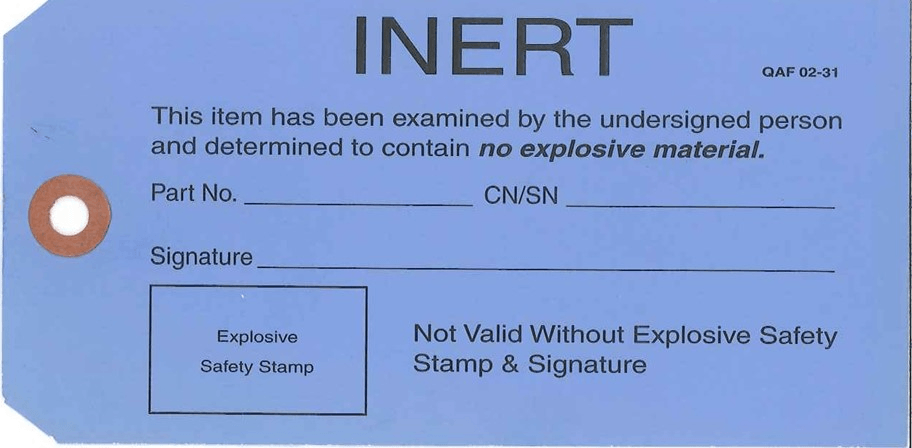
Disposal of expended units
After units have been detonated, if dispositioned as scrap, they shall be disposed of in accordance with environmental and Kaman regulations. NOTE: ALL explosive elements MUST be completely expended prior to disposal.
All units must be 100% inspected to ensure that all explosives contained have been expended
When dealing with explosives safety MUST take priority.
Under no circumstances shall work be performed without written instructions approved by the ESC.
Always thoroughly review work instructions before beginning work.
In the event of an accident, remain calm and follow written procedure.
You are doing great!
Incident Info:
Notes after an incident occurred:
First Aid
If you have been properly trained/certified administer first aid to the individual until emergency responders arrive.
DO NOT attempt to move the person unless their safety is in jeopardy.
Secure the area
Shut off power to any equipment; unless this action will compromise safety.
Keep area clear and DO NOT disturb anything until the Explosive Safety Committee chairman or a representative arrives.
Accidents where there are no personnel injuries shall be handled as follows:
Discontinue work on the operation/equipment
Immediately notify the area supervisor
Notify the Explosive Safety Committee and EHS
Keep the area clear of personnel.
Do not disturb anything until Explosive Safety personnel arrive on the scene.
Do not resume operations until notified to continue by the area supervisor and the Explosive Safety Committee.
Notes: General Explosive Safety Rules:
NO FOOD OR DRINK IN ASSEMBLY AREAS AT ANY TIME.
SAFETY GLASSES WITH SIDE SHIELDS REQUIRED IN DESIGNATED AREAS.
GROUNDED WRIST STRAPS AND SHOES/SHOE STRAPS (IF REQUIRED) IN EXPLOSIVE ASSEMBLY AREAS AND AT WORK STATIONS WHILE HANDLING EEDs.
NO CIGARETTES, MATCHES, LIGHTERS, OR OTHER FLAME OR SPARK PRODUCING ITEMS ALLOWED IN ASSEMBLY AREA.
NO EXPLOSIVES IN OFFICES, CUBICLES, CONFERENCE ROOMS, BREAK AREAS, ETC.